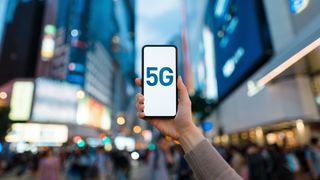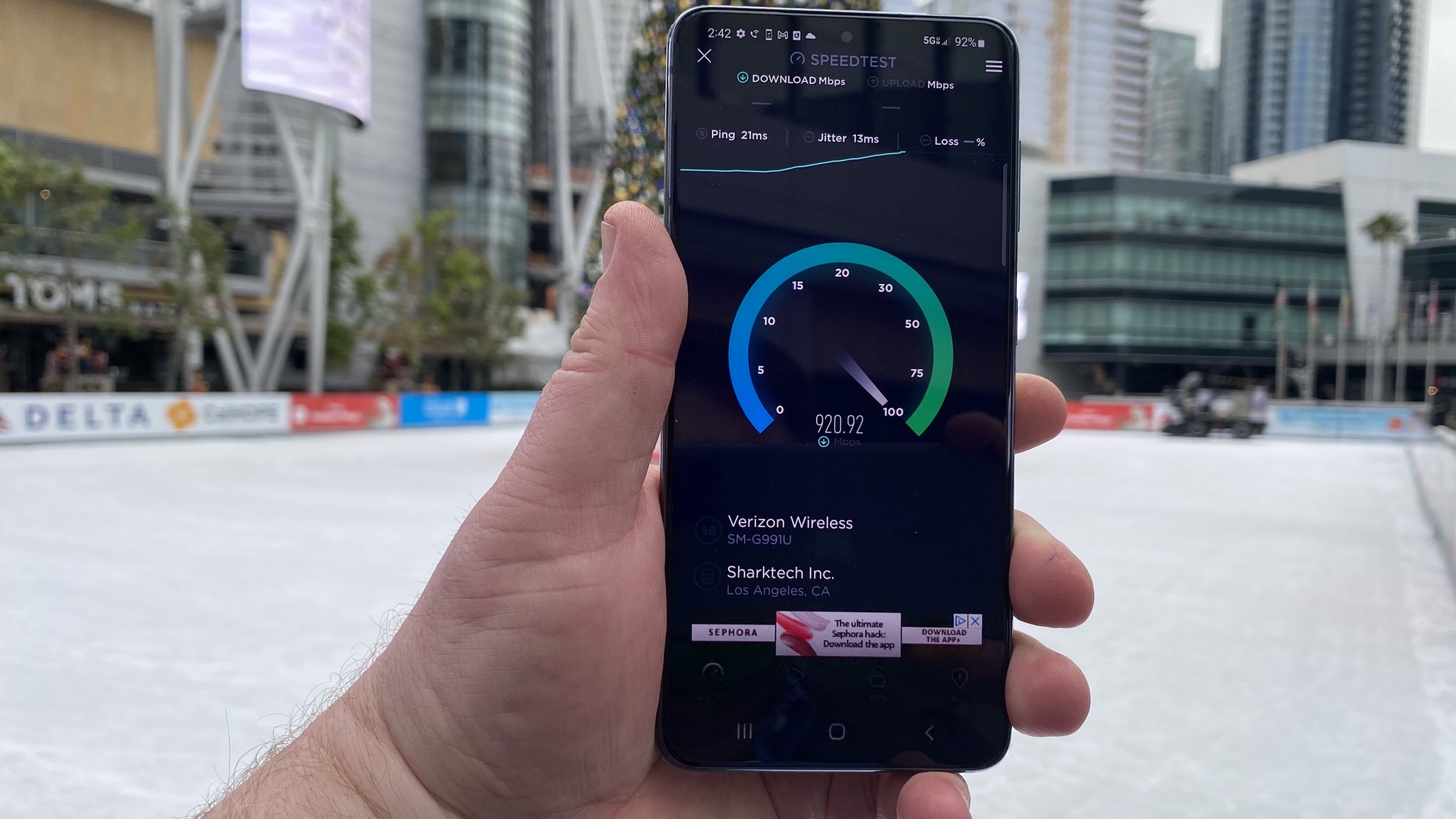What is C-Band 5G and why is it so controversial?
What is C-Band 5G and why is it then controversial?

AT&T and Verizon are ready to launch revamped 5G networks that should mean faster download speeds that cover a wider area for more people with the best 5G phones. The initial 5G networks launched by those carriers just offered modest gains over LTE speeds. The areas that did have high-speed coverage were limited to select sections of a few cities. But this revamped course of 5G based on C-Band spectrum figures to dramatically improve things if you get your 5G service from either AT&T or Verizon.
Then what's non to like? Plenty, if you happen to be running an airline.
AT&T and Verizon have kept pushing back the launch dates for C-Band 5G, amid concerns from the aviation manufacture that the new signals create potential safety hazards for planes. Even now, with the launch of C-Band-based 5G imminent, AT&T and Verizon have both agreed to punch back their launches by not activating the new service on towers well-nigh select airports. Fifty-fifty so, it'south an consequence dividing wireless carriers and airlines, even pitting government agencies confronting one some other.
Here's a quick overview of C-Band 5G and why this new form of 5G is proving to be so controversial.
What is C-Band spectrum and what does information technology hateful for 5G?
Up until now, 5G networks accept relied on two different kinds of spectrum —sub-6GHz and millimeter wave (mmWave). The erstwhile has a broad achieve, forming the backbone of most nationwide 5G networks, but information technology's non very fast. In our testing, sub-6Hz 5G installations take been only a piddling chip faster than the 4G networks they're meant to supercede. mmWave 5G is the faster standard, but you've got to be within sight of a tower to relish fast speeds. Also, mmWave signals can't become around obstacles like buildings and windows.
C-Ring is a relatively uncrowded part of the wireless spectrum that'south been used to build out 5G in other parts of the world. Last yr, the FCC auctioned off 5G spectrum to the highest bidder, with Verizon grabbing the largest share of spectrum, followed by AT&T. Those carriers are adding C-Ring to their existing 5G networks, which volition not only bolster speeds, simply allow those faster speeds to take greater attain.
Take Verizon, which spent most of the past 2.5 years setting upwardly mmWave-based coverage in parts of 87 cities. Those mmWave-based towers are fast, only to enjoy their speeds, you need to be inside sight of i of those towers. C-Band'due south going to remove that obstacle, so that more than Verizon customers volition see faster 5G overall. (Our C-Band testing last month found that subscribers with the all-time 5G phones are going to enjoy faster speeds in more areas.)
What are AT&T and Verizon planning to do with C-Band 5G?
Both AT&T and Verizon are prepare to throw the switch on their updated 5G networks. In Verizon's case, the carrier was ready to go two weeks ago, but postponed the launch at the request of U.Southward. government agencies — we're getting to why in a moment. Today (Jan 19) is the day Verizon'due south supposed to make its faster 5G available to more people, with service reaching some 90 million people — Verizon's original goal, touted two weeks ago, was 100 million people, just Verizon'due south refraining from launching its C-Ring 5G on towers near select airports.

Too, AT&T is expected to launch its C-Band 5G today, though it's been less explicit almost how may people volition exist covered by the faster speeds initially. Final Oct, AT&T said 70 to 75 million people in the U.S. would exist covered by C-Band 5G by the finish of 2022. We're expecting more than details from AT&T shortly.
What about T-Mobile?
Nosotros haven't mentioned T-Mobile still, because the carrier is taking a different approach to its 5G network. T-Mobile was the first to launch a nationwide 5G network, doing so at the end of 2019. In the subsequent two years, the Uncarrier has taken the spectrum acquired from its merger with Dart to build up 5G speeds with its Ultra Capacity service that now reaches 200 million people. In Ookla's most recent written report on wireless carrier performance, T-Mobile ranked first for both 5G speed and availability, and then you lot can run across why the other carriers are eager to launch C-Ring 5G.
That's non to say that T-Mobile doesn't have any C-Band spectrum of its own to eternalize its 5G network. But the carrier isn't planning any C-Ring implementation until 2023.
Why are airlines and the aviation manufacture objecting to C-Band 5G?
As eager as AT&T and Verizon might be to get their new 5G deployments live, airlines are just as eager to pump the breaks on the upgrade. "The C-Ring is closer to the frequencies used by aeroplane altimeters than previous 5G deployments," explained Avi Greengart, lead analyst with Techsponential. "In the U.S., the 5G we've been using has either been used before for prior wireless networks, or information technology is on actually high frequencies with no power to penetrate a piece of paper, allow alone an airplane."
Specifically, the airline industry is concerned that C-Band 5G will interfere with altimeters and touch the ability to safely state planes in low visibility. A contempo letter of the alphabet signed by the CEOs of 10 airlines warned that implementing C-Band 5G could atomic number 82 to airlines scrapping flights out of safety concerns. On a typical 24-hour interval "more than 1,100 flights and 100,000 passengers would be subjected to cancellations, diversions or delays," the letter warned.
Similar frequencies [to C-Band 5G] are already in apply in Europe with no issues observed. If the airplane's altimeter filters are working properly, there should exist no interference whatsoever.
— Avi Greengart, Techsponential
Is the aviation industry right to exist concerned? "From a technical standpoint, not really," Greengart said. "There is a 200 Mhz buffer zone betwixt C-Band and altimeter frequencies, and the part of C-Band that is opening up this week is fifty-fifty further from that betoken. Additionally, similar frequencies are already in use in Europe with no problems observed. If the airplane'due south altimeter filters are working properly, at that place should exist no interference whatsoever."
There is a concern that older altimeters may not be in the clear, and that they'll need to be updated or replaced. That takes coin, and that'south at the heart of the aviation industry'southward objections. "The airlines don't want to pay for those upgrades just considering the FCC gave side by side frequencies to wireless operators," Greengart said.
Nevertheless, fears of 5G interference has led to a cascade of U.Southward. flying delays and cancellations.
Is this a new complaint?
Not hardly at all — and that's led to some noticeable frustration amid wireless carriers who seem to be wondering why the situation hasn't been resolved by at present.
Both AT&T and Verizon had initially targeted 2021 launches for their respective C-Band 5G, only to table those plans at the asking of federal aviation officials. A January 4 launch was delayed for two weeks when U.S. Transportation Secretary Pete Buttigieg intervened. And now, correct before another launch, AT&T and Verizon both agreed to non enable C-Band 5G at towers near select airports — something neither carrier sounded especially pleased by.
"The Federal Aviation Assistants (FAA) and our nation'southward airlines have not been able to fully resolve navigating 5G around airports, despite it existence safe and fully operational in more than 40 other countries," Verizon noted in its statement.
"We are frustrated by the FAA's inability to practice what nearly 40 countries take done, which is to safely deploy 5G technology without disrupting aviation services, and we urge it do so in a timely way," AT&T said in a statement of its ain.
What happens next?
C-Band 5G sounds like it's going live today whether airlines like it or non — though not as widely spread equally the carriers originally envisioned. "Barring someone walking in with a barrel of money to placate the airlines, carriers are going to plow on the frequencies with buffer zones around airports, and so we'll see if the FAA actually mandates anything in terms of flight restrictions," Greengart said.
That will accost the initial launch of C-Band 5G. Only eventually, carriers are going to want their new networks to enjoy a wider reach. And that's a dispute that's going to need to be settled at some point in the near future.
Source: https://www.tomsguide.com/news/c-band-5g-networks
Posted by: kinghistorl.blogspot.com


0 Response to "What is C-Band 5G and why is it so controversial?"
Post a Comment